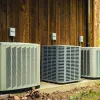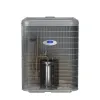Few things remind you how much you love your air conditioner than when it stops working. Maybe it’s taking forever to cool your home, or maybe there’s no cold air blowing through the registers at all. Whatever the case, something is wrong with your AC.
And the problem might be a refrigerant leak. It often is.
Refrigerant leaks can be a big deal… or not.
Let’s look at those times when they’re not such a big deal. Some refrigerant leaks are found at the line set fittings or the valves. When that’s the case, your HVAC technician may be able to tighten a valve or reconnect the fitting to stop the leak. After that, the technician will simply recharge the system with the right type of refrigerant.
Another somewhat manageable type of refrigerant leak is when the leak is in the evaporator coil and the coil is still under warranty. You have to replace the coil, but you get a new one for free. The total cost of the fix isn’t free since there’s labor involved in replacing the coil, but you at least avoid the cost of the coil itself.
More troublesome types of leaks
The most expensive leaks are those that require the replacement of a system component or that affect parts no longer under warranty. When that’s the case, you might need to pay for a new coil or even replace your entire system.
Oh, and if you’ve got an air conditioner with the now discontinued R-22 refrigerant, it’s almost always more economical to replace the entire system in the event of a leak. As of this writing, the R-22 refrigerant is still around, but the cost is astronomical. On January 1, 2020, R-22 will no longer be available for sale anywhere in the United States.
So, how do you know if a refrigerant leak is serious or not so serious? By finding it. That’s how.
Locating a refrigerant leak with an electronic leak detector
Most of the time, an electronic leak detector will accurately reveal the location of a leak. A leak detector is a handheld device with a bendable tip that “hunts” for leaks deep within the AC’s innards. It beeps and lights up when it detects refrigerant.
In most situations where there’s a refrigerant leak, it’s in the evaporator coil and we can find it with an electronic leak detector. After that, it’s the customer’s decision whether to replace the coil or buy a new air conditioner.
Unfortunately, repairing a leak isn’t usually an option. We occasionally find leaks that can be repaired by brazing the refrigerant line set with torches. However, in most cases, you’ll have to replace the indoor coil, the outdoor coil, or the line set. It just depends on where the leak is.
But what happens when the electronic leak detector doesn’t can’t find the leak?
Locating a refrigerant leak via isolation and pressurization
We call this a Level 2 leak search. Sometimes, the leak detector doesn’t show us anything, but we know there’s a leak somewhere due to how the AC is behaving. When this happens, we go through the following steps:
- Disconnect the line set from both units. This involves removing all refrigerant from the system and isolating the line set from both the outdoor unit (condenser coil) and the indoor unit (evaporator coil).
- Braze the line set shut on both ends. We’re essentially welding the line set shut with a torch and solder.
- Perform a pressure test. To do this, we install taps on each end of the line set, pump nitrogen into the line set, and pressurize it to the manufacturer-specified PSI. Then we spray the line set with a soap-like mixture. We look for bubbles, which reveal where the leaks are.
- Do the same thing for both coils. We install taps on the outdoor and indoor coils to see if the leak is in one of those.
- Check the pressure. After 24 or 48 hours, we can confirm that the pressure inside the line set or the coils has dropped (if we saw bubbles, that means it’s going to drop).
Electronic leak detectors are great little tools, but they sometimes fail to locate leaks that are small or in areas that are difficult to access. The Level 2 method will always find a leak when electronic lead detectors can’t!
So, what’s the benefit of knowing where the leak is?
When you know the location of a refrigerant leak, you can make an informed decision about how to deal with it. As we’ve discussed, some leaks can easily be fixed or occur in parts that are under warranty. It’s still inconvenient that your AC stopped working and there will still be a labor charge, but you won’t have to purchase any new components.
However, other types of leaks can be quite costly. Here’s a cheat sheet of potential scenarios:
- Leaks at the fittings or valves: These can usually be repaired or adjusted on-site.
- Leaks in the line set: You’ll usually have to replace your line set. This could be simple or difficult depending on where your line set is located. For example, line sets that run through walls require more labor to replace.
- Leaks in the indoor or outdoor coil: If your system uses 410-A refrigerant and is under 10 years old, the coils are probably still under warranty. You can just replace the coil that’s leaking. If you’ve got a 410-A system that’s more than 10 years old, you’ll have to purchase a new coil or replace the system. If your system uses R-22 refrigerant, you should just get a new AC and coil. There’s no sense in buying a new coil that requires an obsolete product (R-22) and installing it into an aging HVAC system.
Keep in mind that by the time we perform a Level 2 leak search, you’ll need to be prepared for the outcome. If the system’s components are out of warranty, there’s a high likelihood that you’ll need to buy a new coil or even a new HVAC system.
When possible, it’s best to hold off on a Level 2 leak search until the weather isn’t too hot. Your AC will be out of commission for a few days while we perform the search, so peak summer isn’t the best time to do this… unless you haven’t got a choice.
Here’s the good news: There’s always a way to find a refrigerant leak, and there’s always a way to get your air conditioner working again.






